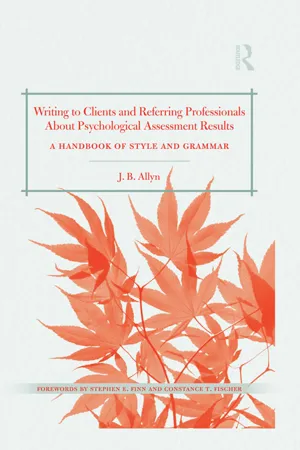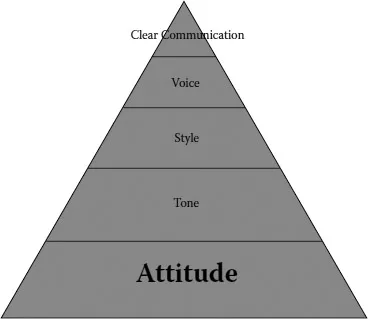![]()
PART I
BUILDING BLOCKS OF THE REPORT
Attitude, Tone, Style, and Voice
Although symbols existed in various cultures in antiquity, the Sumerians are generally attributed with creating written text in approximately 3200 BCE (Wilford, 1999). Writing about medical and scientific topics in the English language began over 1,000 years ago. During those centuries, scientific writing shifted back and forth between a more detached style and a more involved one. It also moved from extensive use of Latin vocabulary to simpler words and style (Taavitsainen & Pahta, 2004). Nevertheless, even simpler scientific style can be difficult to follow for anyone not accustomed to it. When the assessor-writer begins to write reports, s/he may rely on scientific writing. But the intended reader of these reports may not be trained in psychological assessment or even in a scientific field. For that reason, the assessor-writer needs to find a way of writing that is professional and clear for anyone who reads the report.
To reach that point, we move back toward the writing we learned in school, so-called literary writing. The word literary, however, can conjure visions of fiction writing, so we will refer to it simply as effective writing. Types of writing encompassed under that heading are
Descriptive: describes a person, place, or thing
Informative: gives information or explains
Narrative: relates a series of events
Persuasive: attempts to convince the reader (Warriner, 1988, p. 64)
Of these types, persuasive may be used less often and more judiciously in the assessment report: Attempting to persuade your reader may not be the intent of your report or the requirement of your client. Various sections and paragraphs of your report, though, will rely on descriptive, informative, and narrative types of writing.
In the four chapters on effective writing style, most especially in Chapter 4, “Voice,” you encounter the concept of narrative. Narrative is a term often applied to fictional storytelling, but it has a larger meaning. Narrative is the way that we connect events over time and make sense of the whole. In writing, as well as speech, humans tend to “link events narratively” (Richardson, 1990, p. 21). Some of you will be familiar with the term from the field of narrative therapy that focuses on “the stories of people’s lives” (Narrative therapy, n.d.). In writing assessment reports, too, you will be employing narrative to tie together the parts of your assessment. One of the basic qualities of effective narrative is clarity, without needless embellishment.
Psychologist and assessor Gary Groth-Marnat writes of four types of assessment reports—literary, clinical, scientific, and professional (2009a). He believes that few reports fall 100% into the first three categories, suggesting that the assessor-writer may need to use aspects of all three. He describes professional style as including “short words in common usage and that have precise meanings” (p. 561) and cites R. L. Ownby in stressing that approach to writing the overall report. That approach parallels this book’s perspective on effective writing.
Whether writing a report for a third-party referring professional or directly to the person assessed, clear communication is essential. As one assessor put it, “Effective writing is critical for effective assessment” (D. H. Engelman, personal communication, May 2010). Even when writing to a third party, the assessor can assume that the person assessed may read the report at some point. With that in mind, effective communication must also include awareness of and sensitivity to all potential readers.
Figure P1.1 Building blocks of the assessment report.
The chapters in Part I build a pyramid of effective writing style, as shown in Figure P1.1. Clear communication sits as the capstone on that pyramid. Topics in these chapters are interrelated and yet build on each other. Starting with attitude, the chapters proceed through tone, style, and voice in writing. And since writing style is not detachable from content and grammar (Strunk & White, 2000), they, too, weave through these four chapters. In turn, some issues that are more stylistic show up in Part II’s chapters on grammar. Style and grammar work together to create impact in the content of your report.
![]()
CHAPTER 1
Attitude
The Writer’s View
You must not come lightly to the blank page.
Stephen King, American writer
“I never take this lightly. I worry every step of the way—about my writing and about how I phrase facts and inferences in my report,” commented a psychological assessor after reading the King quote that opens the chapter (D. H. Engelman, personal communication, September 2010). Attitude marks the assessor’s starting place for crafting the report; attitude is often values-driven and subliminal, though simple words or phrases can reveal it. Consciously recognizing attitude gives the writer greater control over the impact of written material, strengthening his or her ability to communicate essential data. Who is the intended reader of your report? Is the relationship between assessor and reader direct or implied? What is the purpose in communicating with that person? Is there a secondary audience? Who? And not least important, what is the assessor-writer’s attitude toward his or her own writing abilities? These questions and their answers guide awareness of attitude in writing (see Figure 1.1).
This chapter discusses how written material can convey the assessor-writer’s view of the subject of a report. This material can also demonstrate his or her stance toward the intended audience, whether that be the person assessed, a judge, an educator, or a clinician. Attitude and tone—the latter discussed in the chapter that follows—are less about the basic steps in effective writing and more about your motivation for communicating in the first place.
Figure 1.1Building blocks of the assessment report: Attitude.
What Is Attitude in Writing?
The word attitude in popular usage refers to a person who appears haughty, cocky, or “full of himself.” While that may, indeed, apply in some cases, we will discuss attitude here in its larger definition: “A manner of acting, feeling, or thinking that shows one’s disposition or opinion [italics added]” (Webster’s, 2001).
Regardless how objective a writer intends to be, attitude will be the grounding for what becomes the written word. Even factual material conve...


